International Versions of Famous Filipino Dishes – There are a few dishes that are incredibly unique to Filipinos, but knowing our cultural background means our cuisine shares some similarities with others across the globe. Looking at menus around the world, you’ll find several items familiar and close to our own culture in countries like France, Spain, Germany, and even in Western Africa. Read on to find out how you can grab some Walkman or Betamax but with a twist in other countries.
Betamax vs. Blood Sausage
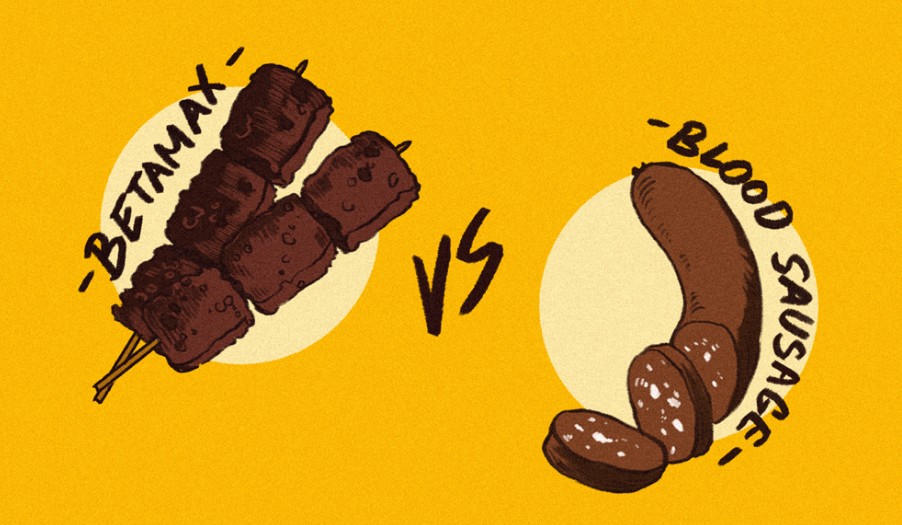
Younger generations may wonder what the heck a Betamax actually is, but this moniker is readily identified with the stick of chicken blood grilled in the open air alongside barbecue, isaw, and the like. This snack derives its name from the black color and the Betamax tape or cube shape that forms after the blood has solidified. Thus, Betamax is no different from blood sausage, a more general term for the dried blood from pigs, cows, goose, lambs, or sheep. Blood sausage takes on names specific to the culture: there’s the morcilla in Spain, black pudding in Ireland, blutwurst in Germany and boudin noir in France. To hold the blood together, fillers such as breadcrumbs, oatmeal, or barley are used, plus the spices specific to the sausage’s region. When meat became a limited resource during wars and times of poverty, other fillers were included to increase the sausage’s volume.
Palaka vs. Frog Legs
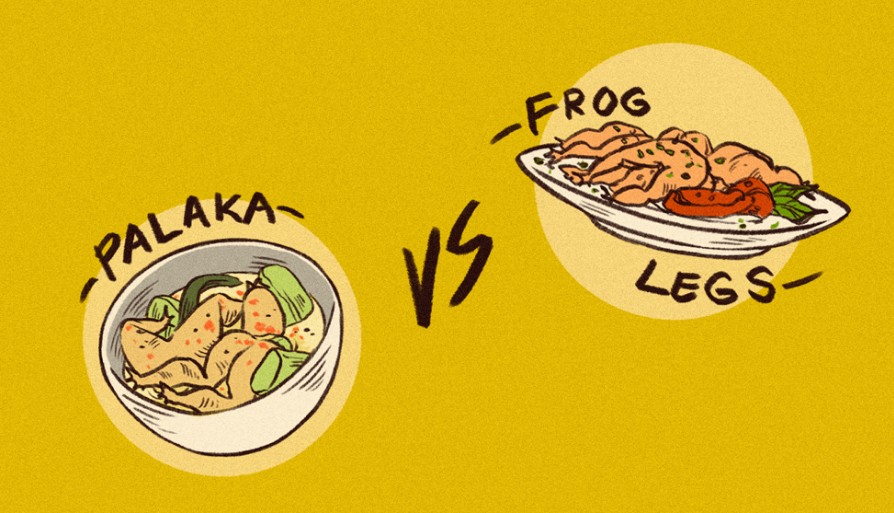
For the not-as-adventurous Filipino, cooked palaka or frog is one of those items one has to try at least once or never at all. In Pampanga however, fried palaka is found on the menu of the famous Everybody’s Café and is also prepared by locals as “Betute Tugak”, deep-fried frog stuffed with minced pork. The common methods of preparing Filipino food, such as adobo, tinola, and ginataan, also work well with frog meat. The Philippines isn’t the only country to include frogs as a staple food: frog legs were present in China as early as the first century A.D. France is even more famous for frog legs or its cuisses de Grenouille, a recipe that soaks the frog legs in milk before coating it in flour and deep-frying the pieces in butter. The basic pritong palaka recipe is simpler, as it only requires the frog itself and salt and pepper seasoning.
Kuhol vs. Escargot
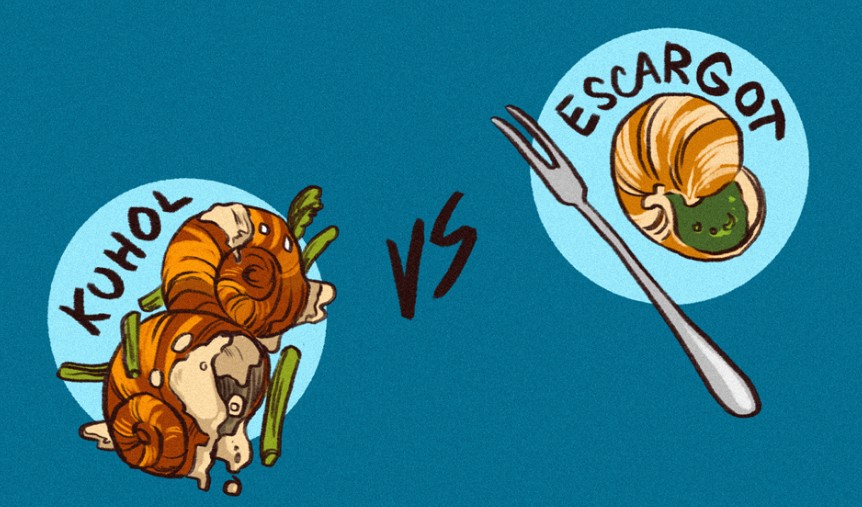
For the metropolitan Filipino, kuhol or snails count as exotic, but there are a number of us who grew up looking forward to this dish at family reunions. Kuhol is usually prepared in gata or coconut milk, a popular base for stewing in Quezon, Laguna, Bicol, and the southern parts of Mindanao. There are various ways of preparing ginataang kuhol, but most recipes add the snails to sautéed garlic and ginger before allowing them to boil in the coconut milk. The French serve snails as escargot, preparing them by removing the the snails from their shells and then placing the butter, parsley, garlic, and wine in the shells before placing the snails back inside.
Humba vs. Pork Trotter
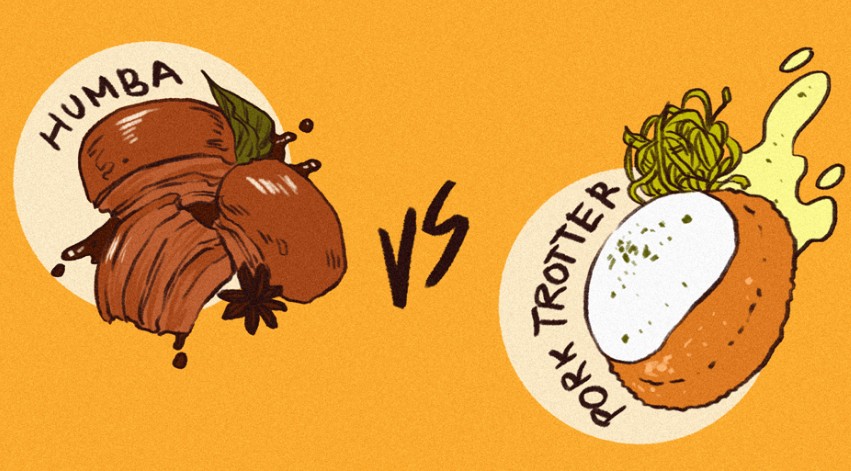
Humba is a variation of adobo served in households across Visayas. It follows the preservation principle of adobo by immersing pork parts such as the pork belly and pork trotters or feet in vinegar and soy sauce. To maximize the pig’s parts, pork hocks are also included in humba. Spain values the pig as much as Filipinos do, and Andalusia makes the most of the animal’s parts, pig trotters included. Andalusians prepare the trotters in ways that range from stuffing them, serving them crispy, or boiling them in a stew to a slow braise. Eventually chefs like Tom Colicchio, Chris Cosentino, and Fergus Henderson introduced various recipes for pork trotters in the early 2000s to the dining scene. Even our version took center stage when Saveur magazine highlighted the fried pigs’ feet of Patio Filipino.
Kare-Kare vs. Maafe
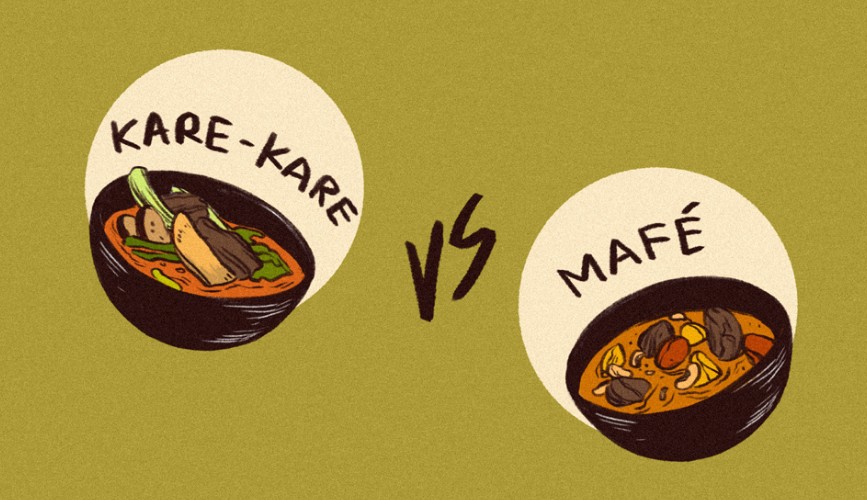
“The Filipino host feels he must stuff his visitor until the poor fellow can hardly breathe. Otherwise he has not been a good host,” reads the introduction to a kari-kari (spelled as such in the book) recipe in Gilda Cordero Fernando’s The Culinary Culture of the Philippines. One plateful of kare-kare stuffs the belly with vegetables, pork hocks, and tripe cooked in achuete water and peanuts. Gambia and Senegal in Western Africa have a traditional dish similar to kare-kare called mafé (maafe, maffe, mafe are the other spellings). Instead of ox parts, they use mutton or lamb, then add the crushed peanuts to the sautéed meat and chopped vegetables.
Lugaw vs. Congee
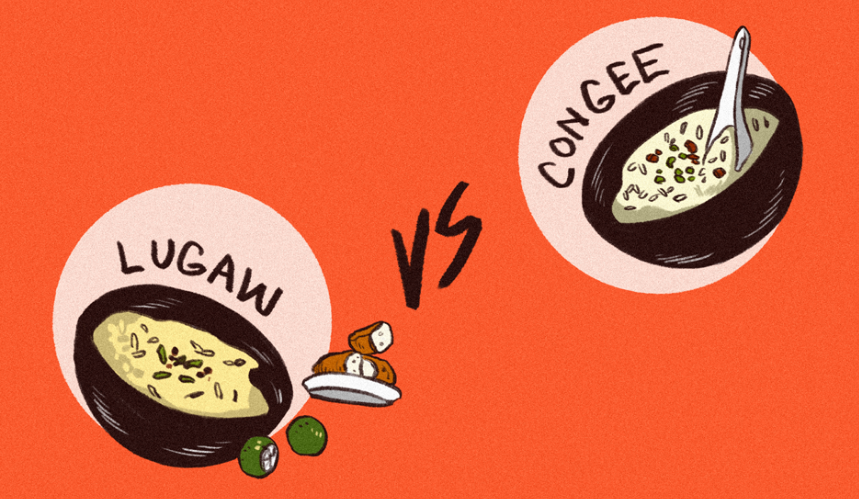
Whether on a rainy day, during a flu spell, or as your go-to breakfast, lugaw is a signature comfort food that warms any occasion. It’s technically just sticky rice boiled in water, but its most basic ingredient allows for a combination of toppings and flavors chosen according to your preference. Anything from the simplicity of soy sauce with kalamansi, a few dabs of patis, to sinking pieces of tokwa’t baboy, fried garlic, scallions, goto, and eggs can crowd a steaming bowl of lugaw. Arroz caldo is the other more popular term for lugaw and what most Filipinos enjoy with chicken, sliced scallions, toasted garlic, kasubha, and ginger. Lugaw is also named according to its ingredients: there’s lugaw hibi (tiny, dried shrimps), lugaw tainga (pig’s ears), lugaw tokwa’s baboy), and lugaw dila (pig’s tongue). Across Asia, lugaw is referred to as “congee” and like lugaw, is named according to the preparation style.
Walkman vs. Pig’s Ears

Like Betamax and Adidas, Walkman is another unique term coined in the days before iPods. The pig ears are shaved and the outer skin removed before being cleaned, sliced and marinated for an hour. In this street food favorite, one can taste soy sauce, vinegar, garlic and peppercorn flavoring the soft pig part. Its name has remained relevant to the street food scene despite it being years after Sony introduced the Walkman.
Pig ears are also eaten similarly or in different ways in other cultures. Spain also serves pig ears as oreja de cerdo, where the ears are fried in high heat oil. Okinawa, Japan burns off the hair in the pig ear before steaming or boiling the parts and then serving the ears in shredded pieces. Swanky Americans have recently become more experimental with such parts. In 2012, The Lukshon restaurant served thinly sliced pig ears marinated in Sichuan spices, white sesame oil, and black vinegar plus scallions and pickled carrot slices for an L.A. Times taste event.
Adidas vs. Chicken Feet

Given the Pinoy tendency to switch general terms for brand names, it only follows that barbecued chicken feet are named Adidas. This street food staple derives its flavor from its sugar, spice, and calamansi-based marinade. Chinese restaurants also serve deep-fried chicken feet that are braised and marinated in black bean sauce. The black bean variation cooks the feet in wines like Marsala, Chinese rice wine and/or sherry, star anise, ginger, honey, soy sauce, and oyster sauce.
Patis vs. Fish Sauce
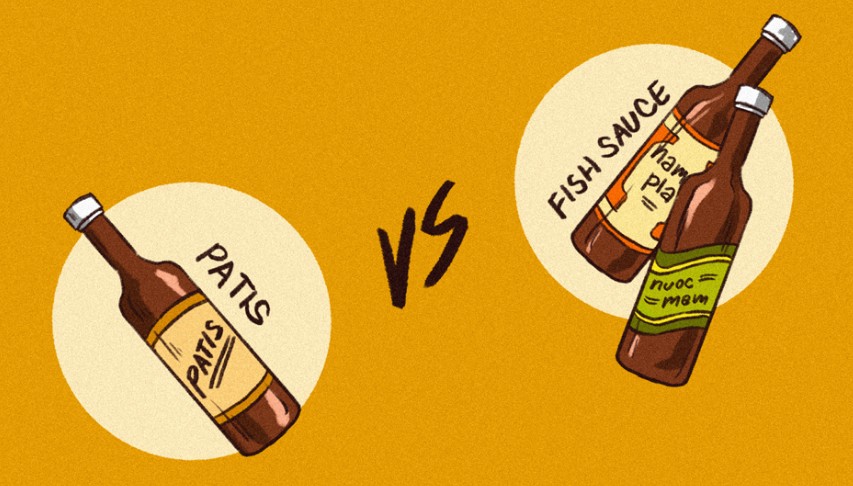
A Pinoy household can do without ketchup or mustard, but its members will definitely panic once the patis has run out. This salty sauce made from fermented fish is crucial to flavoring the chicken in your tinola, among many others. Patis is also the go-to sawsawan or dip for not just boiled meat and vegetables, but also for making one’s rice or grilled and fried meat a little more salty. The small fishes that aren’t sold at big prices are used to make this thin sauce. The oldest and simplest method involves keeping the fish in large earthen jars that contain salt until the fermentation process develops a liquid. This fish sauce can also be found in other Asian countries, and is called nam pla in Thai, nuoc mam in Vietnamese, and petis in Indonesia.
Leche Flan vs. Creme Caramel
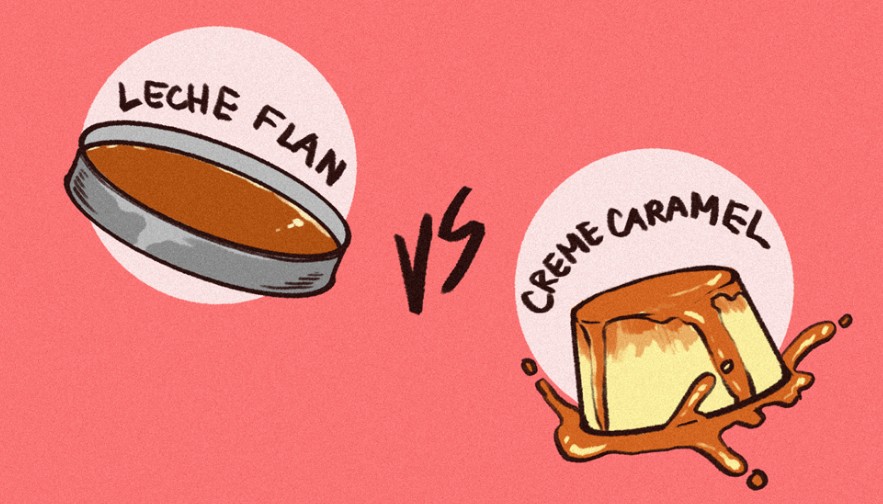
No family reunion, Christmas dinner, New Year’s party, or Filipino themed dinner is complete without ending the meal through a spoonful of leche flan. Leche flan derives its sweet taste from its use of only water, sugar, eggs, egg yolks, evaporated and condensed milk, and caramel. The caramel is made from heating the brown sugar until it becomes thick. France also has its own version in the form of crème caramel, which uses the same ingredients but with cream (single or heavy, depending on the recipe) as well.
Canned Corned Beef vs. Corned Beef
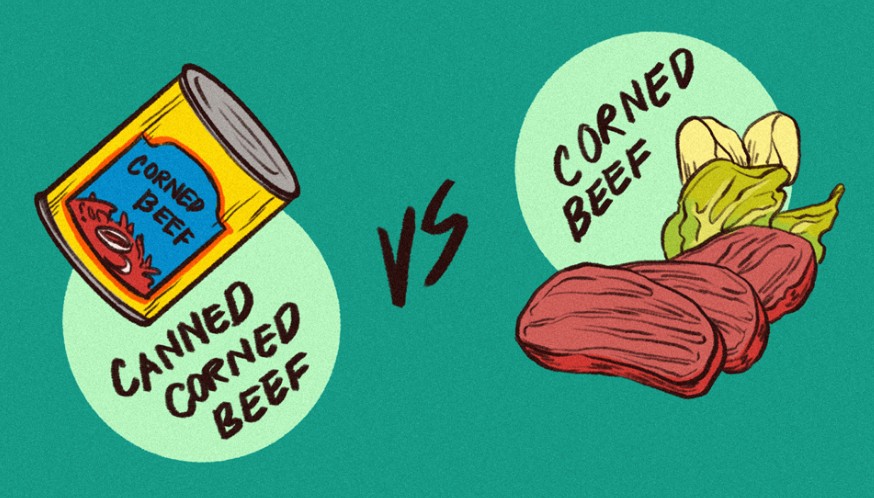
We have the Americans to thank for bringing canned corned beef to our shores during the post-war years. What was once a war ration is now a required grocery item when restocking the kitchen pantry. Unlike canned corned beef’s original purpose, Filipinos add a little more flavor by sautéing onions, tomatoes, and potatoes with the canned meat. The corned part of the name actually stands for the salt used to preserve meat, but in Britain, corned beef is actually bully beef. The term bully comes from the French word “bouilli,” which stands for boiled. Although the Americans provided us with the canned kind, what’s eaten on their side of the world is served as a beef cut in the Reuben sandwich. Round cuts of the beef or the brisket that are cured in seasoned brine are what can be eaten in the US. The Irish-American version serves the corned beef slow-cooked with cabbages, potatoes, and carrots.
article and images credits to: pepper.ph

















